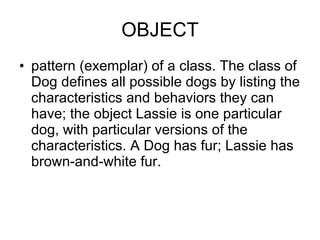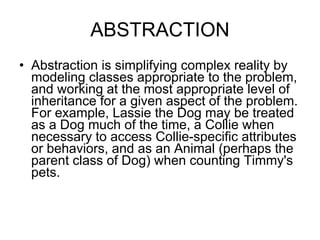Chapter2 java oop
- 1. CHAPTER 2 OBJECT ORIENTED PROGRAMMING JESS DALE DELA CRUZ
- 2. Ã˝
- 3. Object-oriented programming ( OOP ) is a programming paradigm that uses " objects " – data structures consisting of datafields and methods – and their interactions to design applications and computer programs. Programming techniques may include features such as information hiding , data abstraction , encapsulation , modularity , polymorphism , and inheritance . It was not commonly used in mainstream software application development until the early 1990s. Many modern programming languages now support OOP.
- 4. Ã˝
- 5. OBJECT pattern (exemplar) of a class. The class of Dog defines all possible dogs by listing the characteristics and behaviors they can have; the object Lassie is one particular dog, with particular versions of the characteristics. A Dog has fur; Lassie has brown-and-white fur.
- 6. Ã˝
- 7. INSTANCE One can have an instance of a class or a particular object. The instance is the actual object created at runtime. In programmer jargon, the Lassie object is an instance of the Dog class. The set of values of the attributes of a particular object is called its state . The object consists of state and the behaviour that's defined in the object's class.
- 8. INHERITANCE Subclasses" are more specialized versions of a class, which inherit attributes and behaviors from their parent classes, and can introduce their own. For example, the class Dog might have sub-classes called Collie, Chihuahua, and GoldenRetriever. In this case, Lassie would be an instance of the Collie subclass. Suppose the Dog class defines a method called bark() and a property called furColor. Each of its sub-classes (Collie, Chihuahua, and GoldenRetriever) will inherit these members, meaning that the programmer only needs to write the code for them once.
- 9. INHERITANCE
- 12. Ã˝
- 13. Ã˝
- 14. Ã˝
- 15. Ã˝
- 16. Ã˝
- 17. Ã˝
- 18. Ã˝
- 19. Ã˝
- 20. ABSTRACTION Abstraction is simplifying complex reality by modeling classes appropriate to the problem, and working at the most appropriate level of inheritance for a given aspect of the problem. For example, Lassie the Dog may be treated as a Dog much of the time, a Collie when necessary to access Collie-specific attributes or behaviors, and as an Animal (perhaps the parent class of Dog) when counting Timmy's pets.
- 21. OVERRIDDING POLYMORPHISM Polymorphism allows the programmer to treat derived class members just like their parent class' members. More precisely, Polymorphism in object-oriented programming is the ability of objects belonging to different data types to respond to method calls of methods of the same name, each one according to an appropriate type-specific behavior. One method, or an operator such as +, -, or *, can be abstractly applied in many different situations. If a Dog is commanded to speak(), this may elicit a bark(). However, if a Pig is commanded to speak(), this may elicit an oink(). They both inherit speak() from Animal, but their derived class methods override the methods of the parent class; this is Overriding Polymorphism.
- 22. OVERLOADING POLYMORPISM Overloading Polymorphism is the use of one method signature, or one operator such as "+", to perform several different functions depending on the implementation. The "+" operator, for example, may be used to perform integer addition, float addition, list concatenation, or string concatenation. Any two subclasses of Number, such as Integer and Double, are expected to add together properly in an OOP language.
- 23. DECOUPLING Decoupling allows for the separation of object interactions from classes and inheritance into distinct layers of abstraction. A common use of decoupling is to polymorphically decouple the encapsulation, which is the practice of using reusable code to prevent discrete code modules from interacting with each other. However, in practice decoupling often involves trade-offs with regard to which patterns of change to favor. The science of measuring these trade-offs in respect to actual change in an objective way is still in its infancy.
- 24. Ã˝
- 25. Ã˝
- 26. Ã˝
- 27. ENCAPSULATION Encapsulation conceals the functional details of a class from objects that send messages to it. For example, the Dog class has a bark() method. The code for the bark() method defines exactly how a bark happens (e.g., by inhale() and then exhale(), at a particular pitch and volume). Timmy, Lassie's friend, however, does not need to know exactly how she barks. Encapsulation is achieved by specifying which classes may use the members of an object.
- 28. MODULARITY The source code for an object can be written and maintained independently of the source code for other objects. Also, an object can be easily passed around in the system. You can give your bicycle to someone else, and it will still work.
- 29. INFORMATION HIDING An object has a public interface that other objects can use to communicate with it. The object can maintain private information and methods that can be changed at any time without affecting other objects that depend on it Messages
- 30. Ã˝
- 31. Ã˝
- 32. Ã˝































